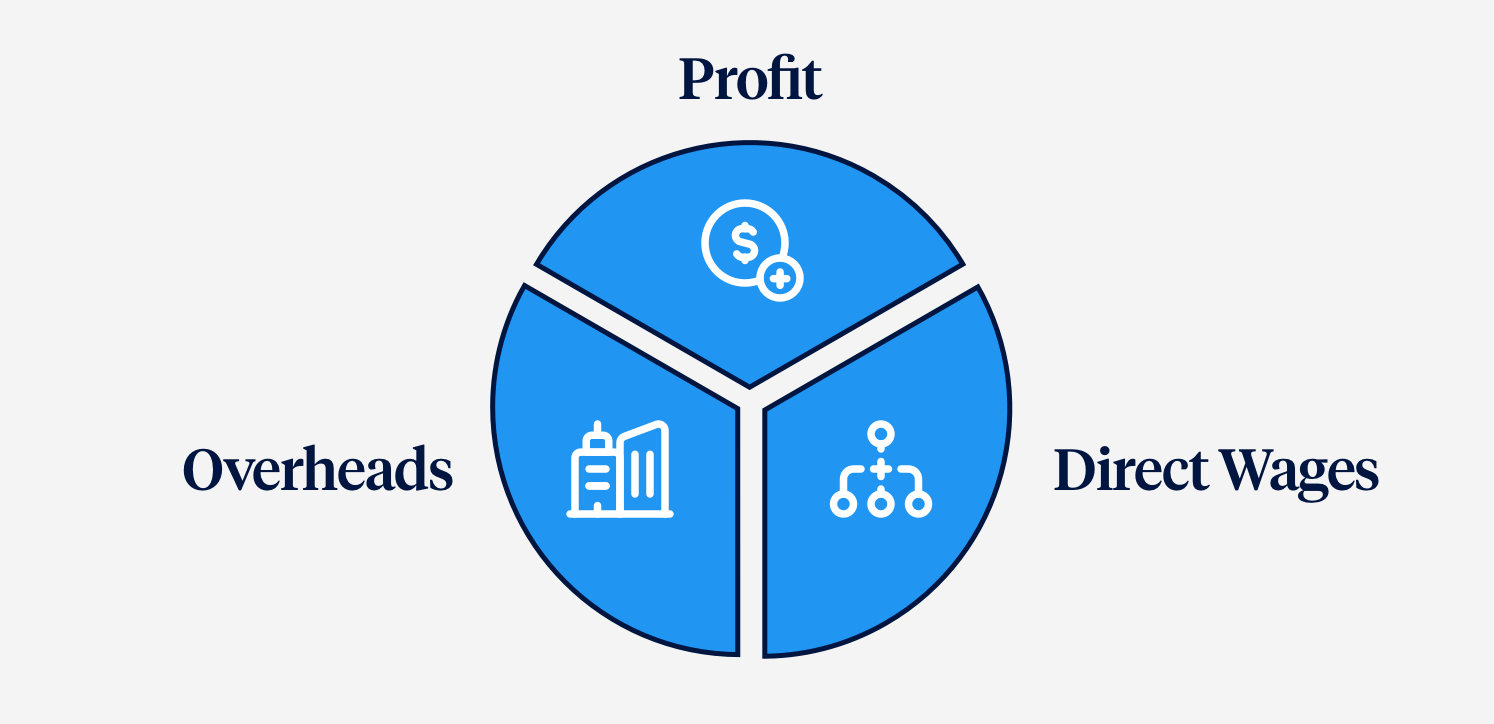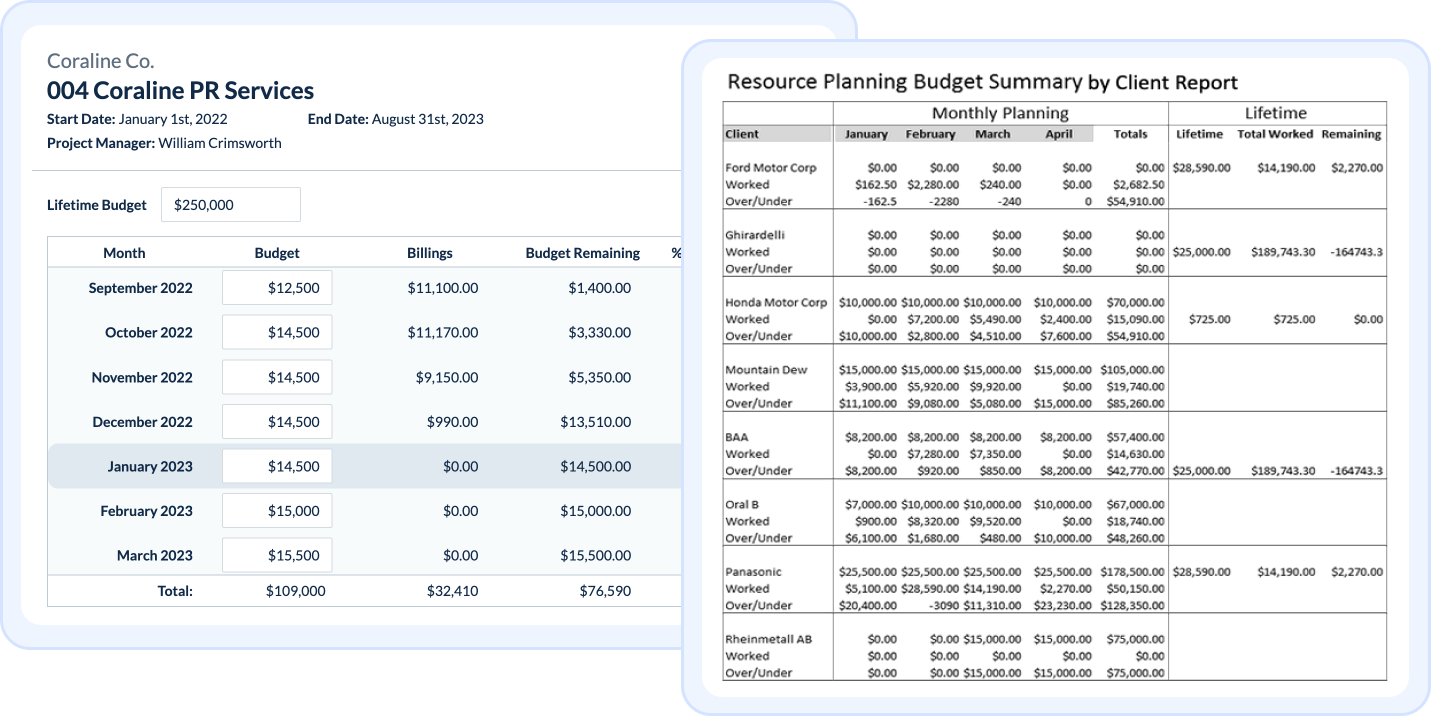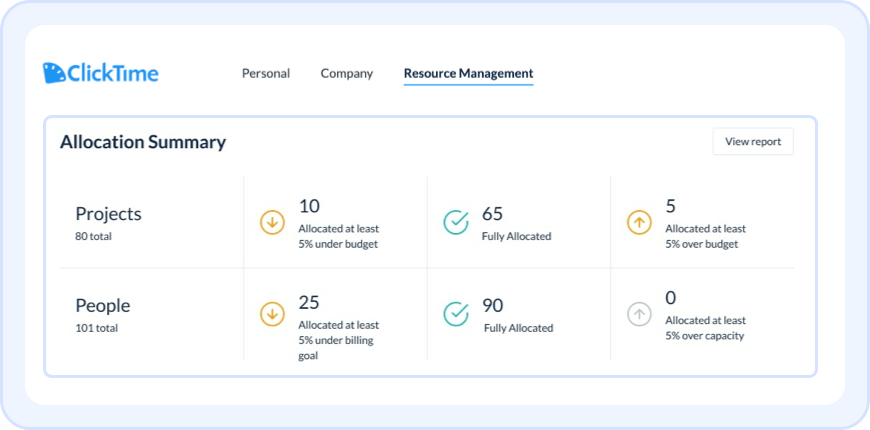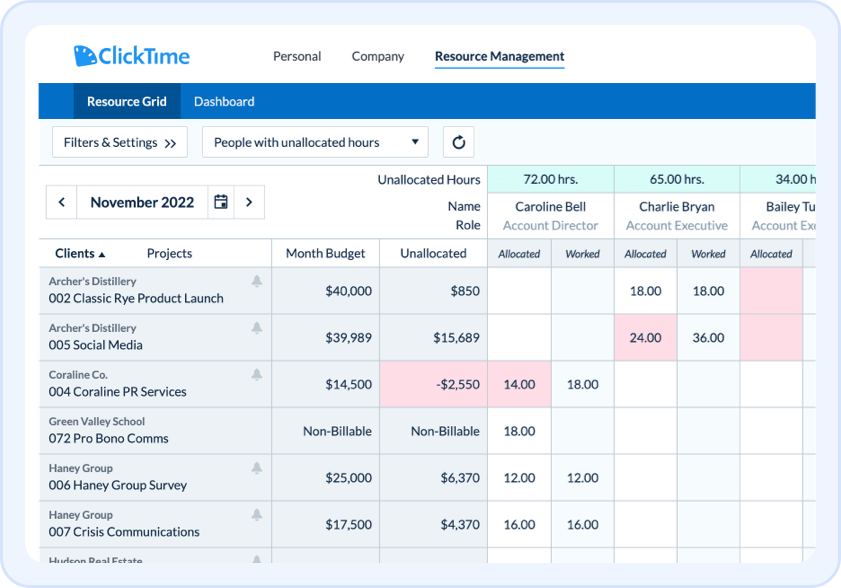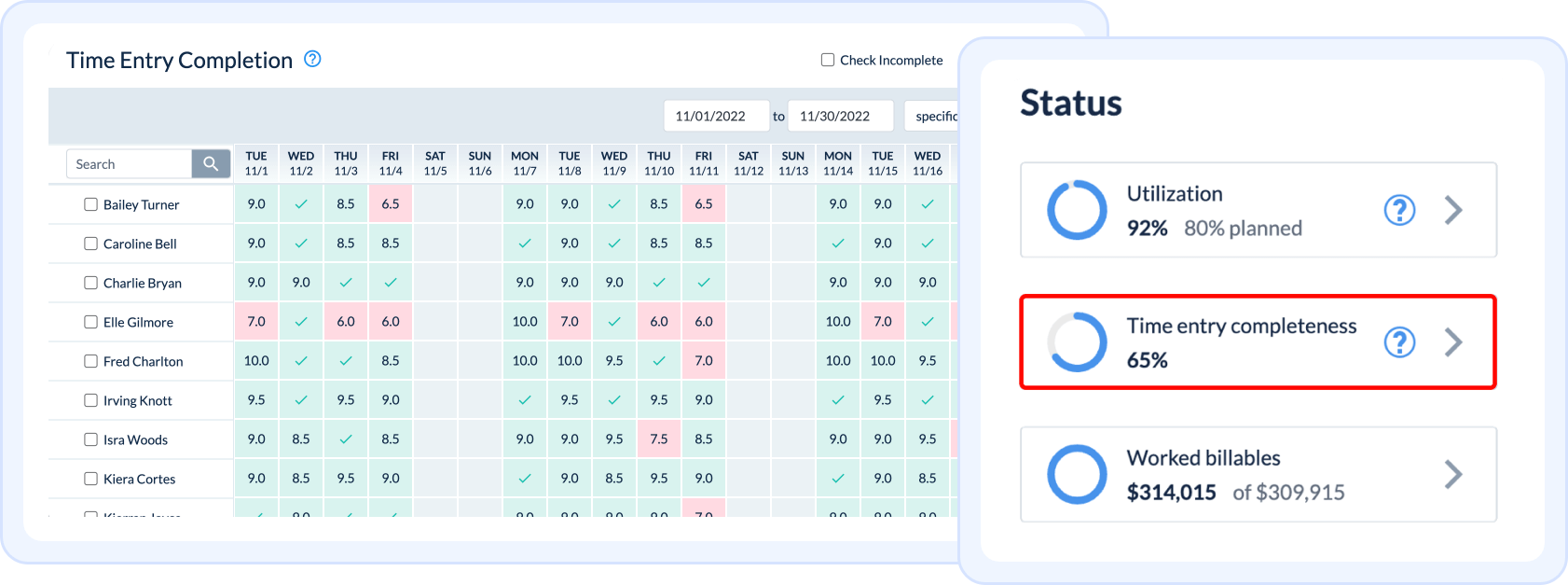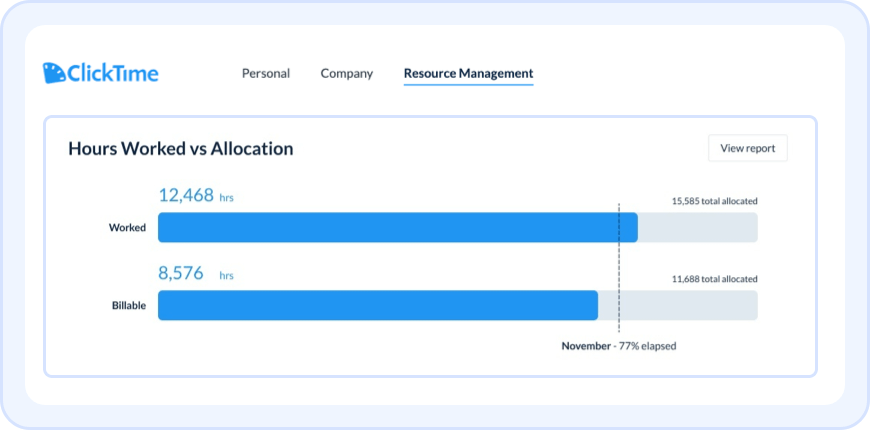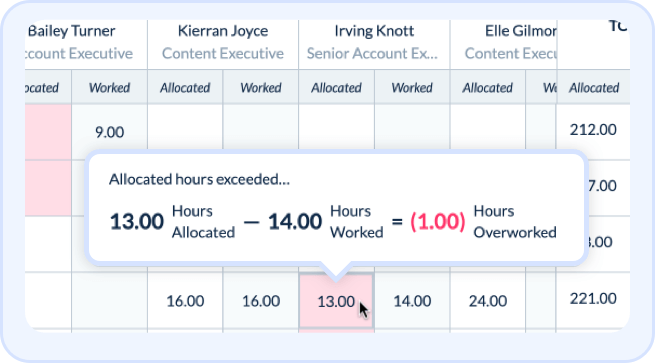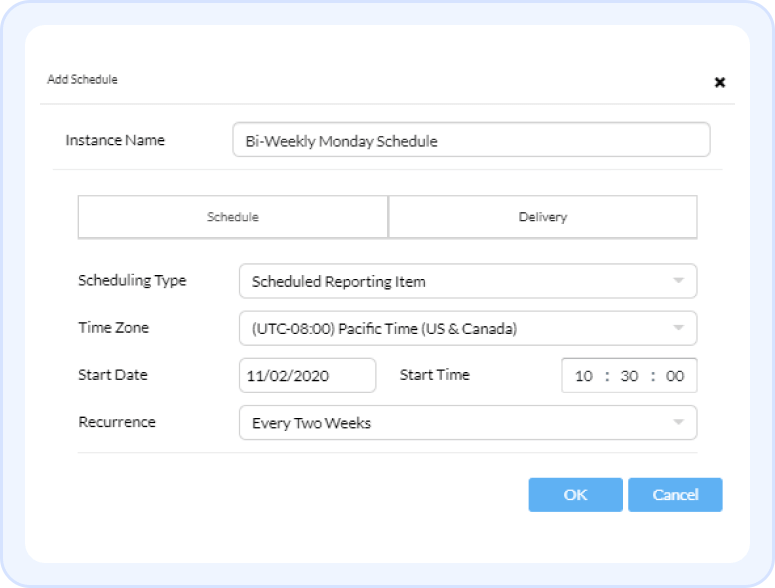How to Increase Your Profit Margins with Excellent Resource Management
Table of Contents
In today’s economy, businesses must focus on increasing profit margins to stay competitive.
And while raising prices may be one option, relying on price hikes alone may deter new sales and cause clients to leave.
That’s why the key to increasing profit margins in the coming years lies in keeping costs low through efficient internal operations.
At ClickTime, we’ve helped hundreds of organizations improve their profit margins by optimizing their resource management processes. Resource management – the process of planning, scheduling, and allocating time, people, and money to a program or project – is an area that most businesses struggle with. It is often cited as one of the largest challenges organizations face, contributing to significant amounts of wasted time and capital.
In this article, we’ll show you how excellent resource management can be your key to higher profit margins during economic downturns.
What is An Acceptable Profit Margin?
A survey of digital agencies by HubSpot found that most companies were either uncertain of their profit margins or reported margins between 11 and 20%. This wide variability shows that some firms can produce profit twice as efficiently as others.
However, even a profit margin within this range may not be ideal. For service-based business models, experts recommend following the rule of thirds, which states that for every 1 unit of revenue, 1/3 should be direct wages cost, 1/3 should be overheads, and 1/3 should be profit.
At ClickTime, we commonly see agencies with profit margins ranging from 5% – 40%, with the majority hovering around 15-20%.
How to Diagnose Where Resource Management Inefficiencies are Impacting Profit Margins
The biggest obstacles to higher profitability fall into one of three buckets: poor capacity planning, poor resource planning, or poor employee performance.
Signs of Poor Capacity Planning
Capacity Planning:
Capacity planning is the process of determining the production capacity needed by an organization to meet changing demands for its services. It involves analyzing current and projected demand and determining the resources (e.g., personnel, equipment, materials) required to meet that demand. The goal of capacity planning is to ensure that an organization has the necessary resources to meet customer demand without overspending on unnecessary capacity.
There are a variety of symptoms that agencies experience when they have improper capacity planning processes. Some warning signs that your agency may be leaking profit due to improper capacity planning include:
- Employees consistently working over 40 hours per week.
- You’re spending a large sum of money paying overtime wages.
- Your projects often become bottlenecked due to a missing skill set.
- Your employees are consistently under-allocated, never reaching their billing goals.
Signs of Poor Resource Planning
Resource Planning:
Resource planning is the process of identifying and allocating the resources (e.g., personnel, equipment, materials, etc.) required to achieve an organization’s goals and objectives. It involves forecasting resource requirements, identifying potential resource constraints, and developing strategies to allocate resources effectively. The goal of resource planning is to optimize utilization and minimize waste.
Suppose you believe that your organization has the suitable capacity to complete your work, but you are still experiencing low profit margins. In that case, you may have an issue in your resource planning process. Signs of inefficient resource planning include:
- Your team is spending too much time on non-billable work.
- Your project budgets and timelines are wildly inaccurate.
- Your agency-wide utilization rate is low.
- Your managers are caught off-guard when employee vacations diminish monthly availability.
Signs of Poor Employee Performance
Lastly, if your agency has the right capacity, with excellent resource planning processes in place, but you still aren’t seeing the profit margins you desire – you may have a problem with employee performance. Signs of poor employee performance include:
- You’re overservicing clients unintentionally.
- Employees aren’t completing their work within the (reasonably) allotted time.
- Employees aren’t following your monthly plan; they spend too much or too little time on each project.
- An employee isn’t logging their project hours in real-time, resulting in inaccurate updates on work in progress.
- Your realization rate is low. Poor work quality prevents you from invoicing your clients for every billable hour.
- Your managers are allowing budget overruns without proactively addressing project issues.
Introducing Resource Management Software: The Tool Companies Use to Spend Time Wisely
For agency leaders who are dissatisfied with siloed planning processes, resource management software gives you unparalleled visibility into your team’s availability, billable utilization, and work in progress.
Unlike spreadsheets or other scheduling tools, resource management software provides your managers with real-time information on their staff’s allocated project hours, upcoming workloads, vacation schedules, and actual billings.
With resource management software, teams create more accurate project plans. And they respond to changes in plans faster. This way, you’ll ensure that your entire organization uses its time as efficiently as possible.
How to Increase Profit Margins Using Resource Management Software
Resource management software helps project-based businesses optimize their internal processes. In this section, we’ll look at the 4 Steps our clients use to increase their profit margins.
Step 1: Staff Your Business for Success
Balancing staffing levels with upcoming client demand is crucial to ensuring your firm maintains healthy profit margins.
Staff too conservatively, and you’ll burn your employees out. Not only will this reduce work quality – which may affect your realization rate – but it will also force you to spend more time hiring as employees jump ship for easier jobs. And hiring is expensive.
On the other hand, if you hire too many employees too quickly, you may be paying for workers to sit idle. And that’s not a winning formula for high profit margins either.
With resource management software, you’ll ensure that your firm is always staffed for success. Here’s how:
- Scope Projects Accurately: Increase your scoping accuracy by viewing similar projects’ historical timelines and cost data. This way, you can estimate exactly how many employee hours you’ll need to meet upcoming client demand.
- View Upcoming Workforce Capacity: Account for holidays, employee vacations, and existing project workloads. With resource management software, you can even view historical sick leave data – a crucial variable that often catches businesses off-guard during flu season. Armed with this data, you’ll know exactly how many available working hours your business will have in the coming months.
- View Role-Based Capacity: Segment your upcoming capacity based on employee role. See the availability of each role to determine whether you need more employees with a particular skill set for upcoming projects.
- Quantify Expected Employee Output: If you determine that you need to hire a new employee, you’ll need to set expected utilization rates. Is this employee expected to be 80% billable, or 90%? Calculate the number of billable project hours they can reasonably contribute and input these expectations into your software.
- Right-Size Your Staff: After scoping your projects and viewing your upcoming capacity, meet with your team to determine whether you have the staff and skillsets necessary to service your upcoming projects.
Step 2: Plan to Utilize Your Employees Properly
Once you’re certain that you have the right capacity to meet upcoming deadlines, it’s time to deploy your existing workforce efficiently.
Resource management software acts as a control center for your budget and people managers. It’s a centralized hub to assign billing goals, allocate resources, and monitor work progress.
With dedicated resource management software, you’ll ensure that your resource plans optimize everyone’s available working hours. Here’s how:
- Create Billable Hour Requirements: By creating monthly billing goals within your software, you’ll be able to monitor billing progress. Your managers will tell our system how many billable hours every employee needs to log each month. RM software will aggregate these numbers and set organization-wide billing goals, which your leadership team can monitor in real-time.
- Allocate Resources: A resource planning grid allows your project managers to assign employees project hours easily. In the grid, they’ll see every employee’s current project workload, available capacity, and billable goals. At a glance, they’ll know which employees are overallocated and who needs to be assigned more work. With this information, they’ll place the right employees on the right jobs for the right costs.
- Set Monthly Project Budgets: Your team will be able to input lifetime and monthly budgets – how much you intend to bill – for each project. They’ll be able to view which projects don’t have enough resources allocated to them, and which ones have too many. Many resource management softwares also allow you to set up budget alerts, so managers will know when projects are nearing completion.
Step 3: Manage In-Flight Work
In resource management, no plan survives first contact with reality.
Project scopes change, unforeseen work arises, and staffing levels fluctuate unexpectedly. To optimize your profit margins, you’ll need your managers to actively monitor all work-in-progress, so they can nimbly react when plans change.
With the right software, you’ll receive a real-time view of all worked labor hours, project progress, and budget burndowns. With the ability to alter plans asynchronously, your team will fluidly respond to changing circumstances. Here’s how:
- Ensure Up-To-Date, Accurate Data: If your team isn’t logging their project hours promptly, your data won’t be up-to-date. This will cause you to receive a distorted view of your project progress. The best software provides a real-time view of time entry completeness – both on a company and individual level.
- Compare Allocations to Hours Worked: See how many billable hours your team is allocated each month and how they’re pacing against those allocations. If 75% of the month has elapsed, but only 50% of allocated hours have been worked – you may have a problem.
- Notify Employees of Remaining Project Hours: Once you allocate project hours, employees will receive their assigned hours in their timesheet dashboard. This way, they’ll see which projects they’re supposed to work on and how long they have left to finish their assignments.
- Quickly Spot Budget Overages: Show managers when project budgets are nearing drawdown or have expired. Dashboards will show you how many projects are overallocated or overdrawn, and allow you to drill into reports to gather more information about the problems.
- Identify and Manage “At Risk” Accounts: Receive notifications at critical budget thresholds and enable project and client managers to play a more proactive role in keeping budgets on track.
Step 4: Create a Continuous Feedback Loop
By this point in your Resource Management journey, your staffing levels are optimal, your plans are accurate, and your execution is agile. Chances are, you’ve already increased your profit margins significantly.
Now it’s time to come together as a team and evaluate every stage in your operations.
The best resource management software has granular, customized reporting. This allows your key stakeholders to uncover insights into employee utilization, project profitability, employee effectiveness, and more. Here’s how:
- Track Your Favorite KPIs: Your resource management softwar should come with out-of-the-box reports, bespoke dashboards, and BI Analytics tools. Armed with this reporting functionality, you’ll have all the tools you need to determine how effectively you’re investing employee time.
- Automate Prescheduled Reports: Email reports to key stakeholders at pre-specified intervals. Receive mission-essential reports in your inbox exactly when they’re needed.
- Discuss Results as a Team: Resource management software provides your executive team with a single source of truth. Rather than working off disjointed spreadsheets with disparate data, your team will receive the same high-fidelity view of your business operations. This way, you can spend more time discussing how to improve your operations and less time validating data.
Make Resource Management Your Competitive Advantage
Don’t rely on new business or price hikes alone to increase your profits during an economic downturn. Instead, focus on what you can control – increasing profit margins within your current book of business.
By investing in your resource management processes now, you’ll cut costs, improve project efficiency, and increase worker output.
And when your business runs more efficiently than your competitors, you’ll have a powerful competitive advantage.
Try ClickTime’s Resource Management Software Today
Schedule your demo of ClickTime, and receive a two-week free trial to see if resource management software is right for your team.




